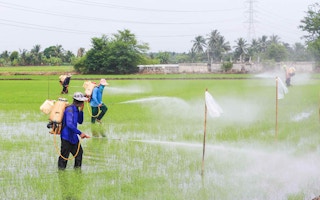A new push to give farmers in developing countries better access to markets, led by the United Nations’ food aid agency, could fall short of its goals if it does not prioritise helping poor farmers adapt to climate change, experts have warned.
Aimed at boosting incomes and improving food security, the project plans to help 1.5 million small-scale farmers across Africa, Asia and Latin America over the next three years with contracts to buy their crops, signed before they are planted, worth $750 million.
The World Food Programme (WFP) and its partners - including agribusiness giants Bayer and Syngenta, the World Bank’s International Finance Corporation, Rabobank and Norwegian fertiliser producer Yara International - will also offer farmers access to agricultural inputs, loans and insurance.
“The platform will enable some of the most marginalised farmers to access reliable markets for the first time,” WFP Executive Director Ertharin Cousin said in a statement as the programme was launched in Davos, Switzerland, late last month.
Half of the world’s 795 million hungry people are farmers, according to the WFP, and in some African countries up to 90 per cent of the population are smallholder farmers.
The UN agency said the pre-agreed purchase contracts with local, regional and international buyers, together with financing and other resources, would enable more than 1 million of the world’s poorest farmers in 25 countries to shift from subsistence farming to market-oriented agriculture.
Experts said that, for the programme to succeed, climate change should be a key factor in deciding which crops to plant.
“Current climate risks which are affecting countries are a big player in the low level of agro-productivity in sub-Saharan Africa,” said John Recha, a specialist with the CGIAR Research Programme on Climate Change, Agriculture and Food Security (CCAFS).
“But I’m not seeing mention of (this) programme being tied to the risks which come aboard because of the changing climate,” he told the Thomson Reuters Foundation from Kenya.
Global warming has led to shifts in rainfall, Recha said, meaning farmers should have the opportunity to grow a range of crops, such as sorghum, cassava or sweet potato, which are more drought-tolerant than the staple maize.
In Rwanda and Tanzania, where the “Patient Procurement Platform” - so-called due to the long-term commitment required from producers and buyers - began in December, maize was the main crop covered by the contracts.
“If you promote more of the maize at the expense of the drought-tolerant crops like finger millet or cassava, then you are not helping these farmers adapt to climate (change),” Recha said.
Mack Ramachandran, who leads procurement for the WFP, said participating farmers would have access to climate-related training, including water management and conservation.
“
Once you start adding fertiliser, it actually kills off the natural fertility (of the soil), so then you become dependent on it.
Teresa Anderson, researcher, ActionAid
“There will be a significant component of climate-smart agriculture,” he told the Thomson Reuters Foundation from Rome.
“Hooked” on fertiliser
CCAFS’ Recha said it made sense to bring the private sector on board to support small-scale farmers and raise their yields by providing them with access to fertilisers, which are under-used in Africa.
But Teresa Anderson, a researcher with development charity ActionAid, warned of the risk that farmers could end up reliant on chemical inputs.
“Once you start adding fertiliser, it actually kills off the natural fertility (of the soil), so then you become dependent on it,” Anderson told the Thomson Reuters Foundation.
“Unless you use fertilisers, your yields will go down, so you can’t just use fertilisers and then stop: you get hooked.”
She said the hybrid seeds farmers may be encouraged to buy from the WFP partners needed a lot of fertiliser, as well as reliable rainfall. That could leave farmers facing a disaster when rains - and their crops - fail, she added.
“It’s not an appropriate response to make farmers more vulnerable by getting them hooked on these chemicals and seeds,” she said.
While insurance may enable them to survive extreme weather, it will not help them adapt their practices to shifting climate risks, she said. Many farmers are now going back to traditional methods, she noted.
According to Ramachandran, farmers in the WFP programme will be able to buy seeds from whichever supplier they prefer, but they will receive recommendations on which seeds are best for their soil and water conditions.
“The farmer choice can never be taken away - they don’t have to buy from Syngenta,” he said.










